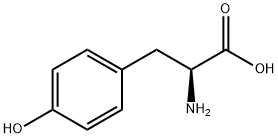60-18-4

CHEMICAL AND PHYSICAL PROPERTIES
| Physical Description | Solid; [Merck Index] White fine crystals and fragments; [Sigma-Aldrich MSDS] |
|---|---|
| Color/Form | FINE SILKY NEEDLES |
| Boiling Point | BOILING POINT: SUBLIMES |
| Melting Point | 343 dec °C |
| Solubility | 479 mg/L (at 25 °C) |
| LogP | -2.26 |
| LogS | -2.57 |
| Optical Rotation | SPECIFIC OPTICAL ROTATION: -10.6 DEG @ 22 °C/D (C= 4 IN N HYDROCHLORIC ACID) |
| pH | 5.66 (at isoelectric point) |
| Ionization Efficiency | Negative |
| Dissociation Constants | 2.06 |
| Collision Cross Section | 145.7 Ų [M+H]+ [CCS Type: DT, Method: single field calibrated with Agilent tune mix (Agilent)] |
| Other Experimental Properties | OPTICALLY ACTIVE |
| Chemical Classes | Biological Agents -> Amino Acids and Derivatives |
SAFETY INFORMATION
| Signal word | Warning |
|---|---|
| Pictogram(s) |
 Exclamation Mark Irritant GHS07 |
| GHS Hazard Statements |
H315:Skin corrosion/irritation H319:Serious eye damage/eye irritation H335:Specific target organ toxicity, single exposure;Respiratory tract irritation |
| Precautionary Statement Codes |
P261:Avoid breathing dust/fume/gas/mist/vapours/spray. P304+P340:IF INHALED: Remove victim to fresh air and Keep at rest in a position comfortable for breathing. P305+P351+P338:IF IN EYES: Rinse cautiously with water for several minutes. Remove contact lenses, if present and easy to do. Continuerinsing. P405:Store locked up. |
COMPUTED DESCRIPTORS
| Molecular Weight | 181.19 g/mol |
|---|---|
| XLogP3 | -2.3 |
| Hydrogen Bond Donor Count | 3 |
| Hydrogen Bond Acceptor Count | 4 |
| Rotatable Bond Count | 3 |
| Exact Mass | 181.07389321 g/mol |
| Monoisotopic Mass | 181.07389321 g/mol |
| Topological Polar Surface Area | 83.6 Ų |
| Heavy Atom Count | 13 |
| Formal Charge | 0 |
| Complexity | 176 |
| Isotope Atom Count | 0 |
| Defined Atom Stereocenter Count | 1 |
| Undefined Atom Stereocenter Count | 0 |
| Defined Bond Stereocenter Count | 0 |
| Undefined Bond Stereocenter Count | 0 |
| Covalently-Bonded Unit Count | 1 |
| Compound Is Canonicalized | Yes |
PRODUCT INTRODUCTION
description
L-Tyrosine, also known simply as tyrosine, is an amino acid. It is an optically active form of tyrosine having L-configuration. It falls under the category of nonessential amino acids since the body can synthesize it from another amino acid, phenylalanine. Acting as the precursor for catecholamines, alterations in L-tyrosine availability to the brain can impact dopamine and norepinephrine synthesis in both experimental animals and likely in humans. In animals, stress induces increased catecholamine release, leading to their depletion, a phenomenon remedied by L-tyrosine supplementation. However, L-tyrosine does not appear to stimulate catecholamine release under basal neuronal firing rates; its effect is observed when firing rates are elevated due to stress.
